
Kale is a versatile leafy vegetable that thrives even in chilly winters. Incorporating kale into your favorite dishes offers a range of possibilities. For example, adding small kale leaves to salads enhances their flavor, while larger kale varieties are excellent for steaming, sautéing, or stir-frying.
One particularly well-known kale variety is dinosaur kale, also known as Tuscan kale or Lacinato kale. It boasts long, crinkly, dark blue- or black-green leaves that can elevate soups, pasta dishes, and salads.
According to The Spruce, kale plants can be harvested while they are young for immediate consumption, or they can be allowed to mature. After harvesting, kale can be stored in the refrigerator for up to a week. If you are unable to grow kale yourself, you can purchase organically grown and GMO-free kale at your local farmers market.
Kale offers an array of health benefits. Just 100 grams of this vegetable provides impressive amounts of vitamins: 389.6 micrograms of vitamin K, 241 micrograms of vitamin A, and 93.4 milligrams of vitamin C. It is considered a superfood due to its numerous beneficial compounds.
A study conducted in 2012 revealed that a particular kale variety contained high levels of beta-carotene and vitamin C. Kale is also rich in indole-3-carbinol, a phytonutrient that may support DNA cell repair, stimulate cell death, and inhibit cancer development. Sulforaphane, another compound found in kale, has been shown to have protective effects against certain cancers, improve liver and gastrointestinal health, and protect against macular degeneration.
Members Only Content
To continue reading please subscribe to WellnessPlus by Dr. Jess MD
Be your own best doctor with our comprehensive suite of online health coaching tools.
